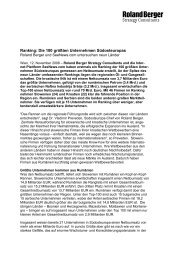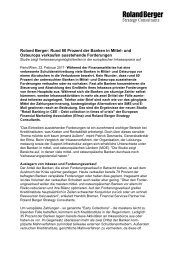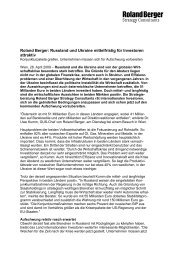Retail Banking in CEE: Exploiting the Potential of ... - Roland Berger
Retail Banking in CEE: Exploiting the Potential of ... - Roland Berger
Retail Banking in CEE: Exploiting the Potential of ... - Roland Berger
You also want an ePaper? Increase the reach of your titles
YUMPU automatically turns print PDFs into web optimized ePapers that Google loves.
32<br />
CROSS-SEGMENT OFFERING – UTILIZING THE LINK OF BUSINESS AND PERSONAL NEEDS<br />
There is room for improvement <strong>in</strong><br />
cross-segment sales resp. service<br />
models as a lot <strong>of</strong> banks use just<br />
ad-hoc campaigns for this purpose<br />
ANALYSIS OF THE STATUS QUO<br />
The majority <strong>of</strong> <strong>the</strong> <strong>in</strong>stitutions have at least an ad-hoc (campaign driven) cross-segment<br />
captur<strong>in</strong>g practice and 77% <strong>of</strong> <strong>the</strong> <strong>in</strong>terviewed banks do apply <strong>the</strong>se models. Out<br />
<strong>of</strong> <strong>the</strong>se roughly three quarters, just 15% have a complete and elaborated methodology<br />
and <strong>the</strong> huge "rest" <strong>of</strong> 85% uses ad-hoc campaigns (see fig. 25). These actions are<br />
usually l<strong>in</strong>ked to one specific product resp. service <strong>of</strong>fer but do not <strong>of</strong>fer a jo<strong>in</strong>t service<br />
model for both private and bus<strong>in</strong>ess needs.<br />
Fig. 25: Cross-segment <strong>of</strong>fer<strong>in</strong>g practices <strong>in</strong> <strong>CEE</strong> banks [%]<br />
Banks not apply<strong>in</strong>g<br />
cross-segment sales/service<br />
23<br />
Banks with methodology for<br />
cross-segment sales/service 1)<br />
15<br />
Banks apply<strong>in</strong>g<br />
cross-segment <strong>of</strong>fer<strong>in</strong>g<br />
77<br />
85<br />
Banks us<strong>in</strong>g adhoc<br />
campaigns 1)<br />
1) Out <strong>of</strong> banks apply<strong>in</strong>g cross-segment <strong>of</strong>fer<strong>in</strong>g<br />
Source: <strong>Roland</strong> <strong>Berger</strong> Strategy Consultants<br />
There is an important l<strong>in</strong>k between micro sub-segments and cross-segment <strong>of</strong>fer<strong>in</strong>g<br />
because cross-segment target groups can be easily orig<strong>in</strong>ated from micro sub-segmentation.<br />
For example, banks may use <strong>the</strong> l<strong>in</strong>k between targeted pr<strong>of</strong>essions and <strong>the</strong> (usually)<br />
private affluent <strong>in</strong>dividuals segment assum<strong>in</strong>g that a lawyer PI client needs a bus<strong>in</strong>ess<br />
account, too. And vice versa, lawyers may be targeted by <strong>the</strong> banks to ga<strong>in</strong> affluent<br />
PI clients.<br />
Manag<strong>in</strong>g both <strong>the</strong> private and<br />
pr<strong>of</strong>essional sides <strong>of</strong> a client relationship<br />
<strong>in</strong>creases <strong>the</strong> gross <strong>in</strong>come<br />
and can even double it<br />
COVERAGE MODELS AND RECOMMENDATIONS FOR <strong>CEE</strong> BANKS<br />
Previous European case studies highlighted <strong>the</strong> follow<strong>in</strong>g important facts:<br />
> Dual relationship is worth 30% to 100% more than s<strong>in</strong>gle relationship.<br />
> The proportion <strong>of</strong> NBI share between <strong>the</strong> private and <strong>the</strong> pr<strong>of</strong>essional side varies<br />
strongly by sub-segment and develops over <strong>the</strong> life cycles <strong>of</strong> <strong>the</strong> bus<strong>in</strong>ess and <strong>of</strong> <strong>the</strong><br />
bus<strong>in</strong>ess owner.<br />
> Market<strong>in</strong>g strategy and product <strong>of</strong>fer require operational and tactical segmentation.<br />
Based on <strong>the</strong>se three facts, <strong>the</strong> split <strong>of</strong> bus<strong>in</strong>ess and private needs <strong>of</strong> clients shall be<br />
exam<strong>in</strong>ed consider<strong>in</strong>g local market-specific sub-segment specialties. The results can<br />
lead to various important conclusions as to <strong>the</strong> optimal client coverage model. In <strong>the</strong><br />
example <strong>of</strong> figure 26, "X1" priority means that <strong>the</strong> client will generate a higher gross<br />
<strong>in</strong>come for <strong>the</strong> bank on <strong>the</strong> pr<strong>of</strong>essional side. Therefore <strong>in</strong> case <strong>of</strong> e.g. <strong>the</strong> triumvirate<br />
coverage model (see fig. 28), <strong>the</strong> bus<strong>in</strong>ess relationship manager shall play a more<br />
important role. At <strong>the</strong> same time for "X2" sub-segments, it is worth focus<strong>in</strong>g on <strong>the</strong><br />
clients' private needs and serv<strong>in</strong>g <strong>the</strong>m ra<strong>the</strong>r as private, not as micro clients.
















